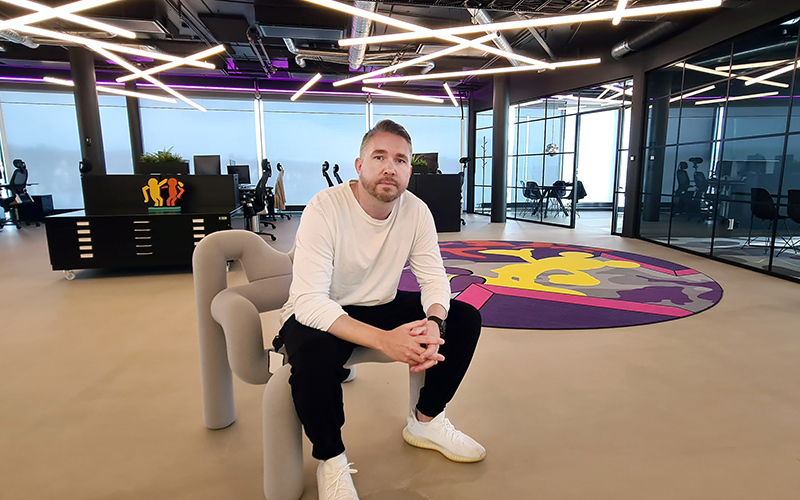 Erling Løken Andersen at Omega Media with a work by Keith Haring in the background.
Erling Løken Andersen at Omega Media with a work by Keith Haring in the background.
"Art is my only goal" — A conversation with Artwork Archive collector Erling Løken Andersen.
Erling Løken Andersen’s art collection is a color-drenched celebration of pop culture, social commentary, and agitprop activism. At only 39 years old, Erling is what some call an “emerging collector,” but his collection combines some of art history’s most infamous personalities, from Haring and Warhol to Koons and Kaws.
Based in Oslo, Erling’s aesthetic defies the traditional Scandinavian minimalism that has come to be synonymous with Nordic style. Instead, he embraces bold graphics, neon palettes and a kind of nu-rave chic — all of which coalesce at the HQ of his company Omega Media (which he designed and curated).
We caught up with Erling to discuss his collection, how it started and how it’s evolved, as well as how his unique professional background — a blend of advertising, law and digital media — has contributed to his collection’s style, and to his understanding of what makes a great work of art.
As Erling says, “Every art collector's story is different, and that also makes an impression on the collection itself.”
The following interview has been edited for length and clarity.
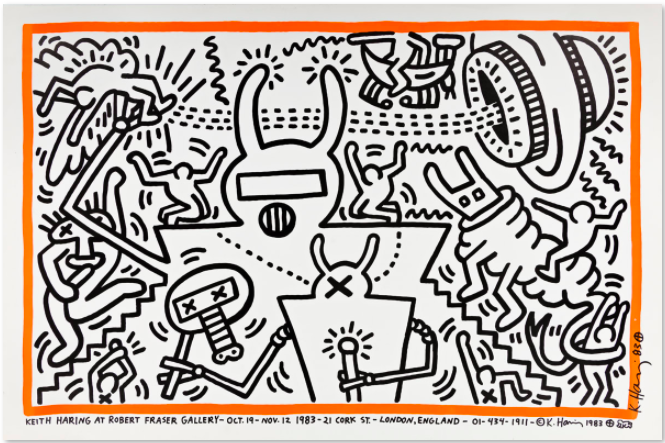
Artwork from Erling's private collection: Keith Haring at Robert Fraser Gallery. Image courtesy Erling Løken Andersen.
AA: How did you begin collecting art?
EA: I had this impression that art was something you had to understand; that it was unapproachable and elitist. Art happened in galleries and I didn't go there. It wasn't until I stumbled upon Banksy's Exit Through the Gift Shop in 2012 that art suddenly "clicked" for me. Banksy made sense of it, he broke down the walls between high brow collectors and the ordinary man. He gave everybody a voice in the art world.
So, I started from there and moved on to artists like Shephard Fairey and Ron English. I'm not too fond of typical street art today, I think it's all the same stenciled flowers and online print drops. But, street art taught me to approach art, to understand the basic concepts, and it helped me develop an appetite for what I like — and I'm very thankful for that.
I think I was highly amateurish in the beginning, as most people are. I bought lots of art I never should have bought. But, then you start talking with gallerists and people who actually know their stuff. So I was taught a lot by them — Joseph from Joseph Fine Art is a fantastic guy, for example.
I’ve learned a lot from museums, namely that there should be some direction in collecting. I learned that from some really good museums here in Oslo actually, especially the Astrup Fearnley Museum, which is an incredible museum. They have an insane collection— one of the biggest in the world. Lots of works by Jeff Koons, for example (they own the Michael Jackson and Bubbles statue).

Works from Erling's private art collection: Mercedes-Benz Rennwagen W 125 by Andy Warhol and Dolphin (Bicycle Rack) by Jeff Koons. All images courtesy of Erling Løken Andersen.
AA: What’s your art style? You seem to have an affinity for very graphic pieces by well-known artists.
EA: I was originally educated as a designer — I went to advertising school for three years and also worked as an art director — so I do have this very commercial, creative approach to whatever I'm looking at. Later, I also became a lawyer and attorney, which — believe it or not — is also a very creative profession.
I like big statement pieces — pieces that will make people stop and actually look at the art. I like colorful, bold art. Like I said, as I've gotten older, I look more for direction in my collecting. In the beginning, I was collecting individual works like ‘Oh, this is a cool piece. And this is a cool piece.’
Now I look more holistically at the collection. And, I want to build something that stands on its own, in a way.
I always look for something that resonates with me as a collector. So I look for art that kind of stands out — I wouldn’t call it mainstream, but maybe MainStreet. And then, I would say, there has to be some kind of interesting dialogue going on with the piece, either in the progression of the artist and his artistic direction or as some kind of commentary on what's happening in the world.
I've developed a taste for the "original" street artist Keith Haring. Haring was never really loved by his contemporary collector peers, but it's hard not to appreciate his influence on street art and the marriage between art, music and fashion. With his toys, clothes and collectibles, he was doing what Kaws is doing now — only 30 to 40 years earlier.
Today, I'm trying to branch out and combine collecting blue-chip artists like Andy Warhol, Henri Matisse, and Jeff Koons with lesser-known artists like Alex Aliume and Norwegian-born Bjarne Melgaard. Still, I would say my collection is quite commercial. I like artists like Warhol and Koons. Do I like them because they are well-known, or are they well-known because they create fantastically inspiring art — and I collect them for that reason? I hope the answer is the latter.
So, with Banksy, of course, everything is extremely dialogue-focused in the political sense. Keith Haring was a very engaged social activist focused on gay rights. Then you have Jeff Koons, and there’s also an extremely interesting dialogue going on there — but it's not on the social activist level, and it's not on the political level. It's more a commentary on the art world itself.
Then you have Damien Hirst, who has a dialogue (or used to) based on death and mortality. What does it mean to be human? Are we ever really healthy? Now I buy Damien’s work mostly because it looks cheerful, which is an extreme contrast to his former "Memento Mori" theme. But, maybe that's also why I like his new work. You can see the development in Damien's mind and psyche — from the morbid obsession with death and decay to colorful paint daubs and cherry blossom trees. Is he in a better place? Art holds no secrets.
So, I think that dialogue is important for me as a collector — to find the voice of the artist hidden inside the work. And that's kind of hard to find.
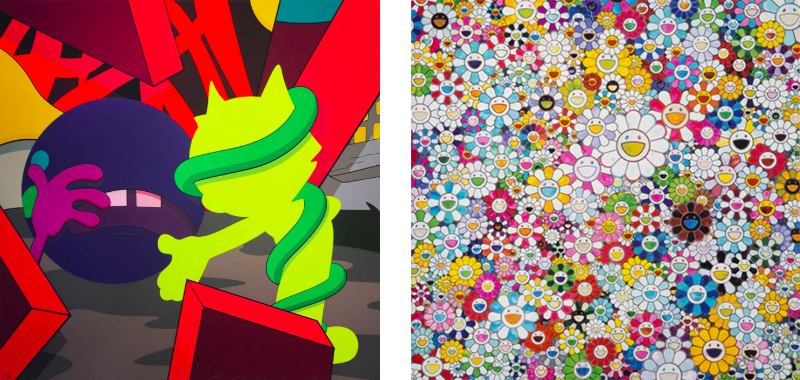 Works from Erling's private art collection: Presenting the Past by Kaws and When I Close My Eyes, I See Shangri-La by Takashi Murakami. All images courtesy of Erling Løken Andersen.
Works from Erling's private art collection: Presenting the Past by Kaws and When I Close My Eyes, I See Shangri-La by Takashi Murakami. All images courtesy of Erling Løken Andersen.
AA: What’s your favorite piece that you own?
EA: Presenting the Past by Kaws is probably my favorite piece that I’ve bought just because I used to really, really love Kaws. On many levels I do think he's becoming kind of like Damien Hirst now — maybe a little overexposed at the moment — but, you know, people are buying it just to have a Kaws. With Kaws, it seems you either hate him or love him. I'm kind of caught in the middle right now.
What I think is interesting about Kaws is this intersection between art and commercial stuff and advertising, which is a common thread for a lot of the artists that I collect.
First, he draws these figures and you can immediately understand what they are — it's SpongeBob and these other cartoon characters— then he moves in an abstract direction where the characters start to dissolve to the point where they're essentially just overlapping lines. Ultimately, when you get to 2019, everything's abstract and it's more or less impossible to see what the original cartoon was.
If you look at Presenting the Past, you can see that there are two cartoon figures there, but they're surrounded by dots and lines and strokes and whatnot. From that piece onwards, Kaws’ work just goes completely off the rails and becomes very abstract. That’s similar to Paper Smile, which is also in the collection, in which you can see the eyes of SpongeBob, but it's all overlaid with some kind of abstract french fries.
Presenting the Past is quite large — it's nearly one-meter square—and its colors are intense. I've never seen another piece quite like it, especially in terms of the color profile. When people walk past that piece, everybody stops, even if they don't know who Kaws is.
When I saw it I just had to buy it — it was also a really “good buy” because I discovered Kaws just before he took off in the market. So I bought that piece for $4,000, which is a good price right now. I saw it sold at auction for more than $30,000. That's a very good feeling; but, of course, the piece is the most central thing. I just love it because it's right at the moment where Kaws goes from a cartoon style to a more abstract aesthetic.
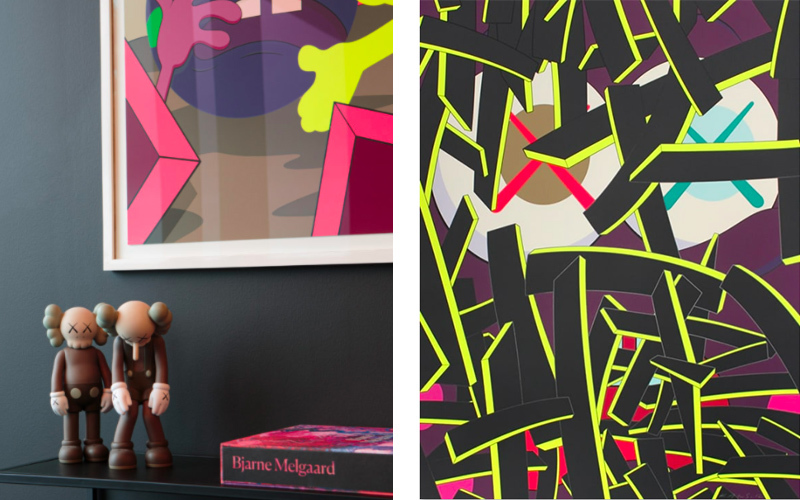 Installation view at Omega Media with works by Kaws. Photo by Nadia Norskott. Paper Smile by Kaws, all photos courtesy of Erling Løken Andersen.
Installation view at Omega Media with works by Kaws. Photo by Nadia Norskott. Paper Smile by Kaws, all photos courtesy of Erling Løken Andersen.
AA: Where do you discover new artworks to add to your collection?
EA: I go a lot to frame shops, actually. Here in Oslo, there are some secret frame shops that only really wealthy people go to and I befriended the guys who run them. So, I get to see all of the art that's currently being framed.
Artsy and Instagram are my go-to places for discovering art online. I also look at Invaluable, which is an auction website. It's a great way for stumbling across new artists because you go into a random auction and just start scrolling. I'm looking at each and every artist, and then I'm reading up on them if I'm more interested. But, I buy every Keith Haring piece that I come across — there is not one single Haring auction that I don't bid on.
I do think Instagram has been pivotal for so many artists, like Kaws. But, I see these street art collectors buying $200 print drops and thinking they just bought the next Banksy, and I think they're primarily motivated by speculation.
They look at art kind of like a lottery ticket — a lot of them want to hit the next jackpot. Like, "I'll buy the next Banksy for $200! And hopefully one day it will be worth $2 million, right?" But I think the people who collect Kaws are a bit more serious about the art and the way they approach art. Even though there’s definitely an influx of rich people who don't really understand art — they just want to buy the social caché of being a collector.
But, you know, art collecting is really an introverted exercise. It's a journey into yourself, to discover what you like and what makes you tick.
It's tremendously satisfying. I run several companies with 30 to 40 employees and that is also very interesting, but the only reason I'm really working is to be able to buy more art.
Art is my only goal; everything else I do, I do because I want to have the time and money to think about art.
AA: How has Artwork Archive supported your art collecting?
EA: I kind of stumbled on Artwork Archive two years ago or so, because, as my collection was growing, I really needed an inventory system. I buy some works privately, and then I have two or three companies that I also buy art for whenever I can. So, I really needed a system that would allow me to do the inventory, and also tell me where — meaning to what company — each piece belonged, because my accountants were getting on my back and giving me all kinds of problems.
So, that's where it started, and then it kind of grew from there — it became kind of an obsession, actually. I like documenting the artwork, ensuring that I have proper provenance, because I'm really collecting for my daughter and my son. So, I really want to pass that on to them. And then, you know, as the collection grows, it's extremely important to maintain the provenance on every single piece.
For me, the fact that you can actually decorate a room with art is basically a huge plus. That's not what I'm mainly interested in — I'm mainly interested in buying and acquiring and appreciating the art — but, then of course it's also fantastic that I have offices where I can actually contribute to the atmosphere with that artwork.
At Omega Media, for example, I did all the interior design. I designed the yellow table in the reception area and those Kaws-inspired round carpets — I designed those, too. Because I had the Presenting the Past, I wanted some floor pieces that matched the artwork (but of course it's impossible to buy any Kaws carpets). Some of my favorite pieces from Andy Warhol are his camouflage canvases, so basically I took some camouflage patterns and overlaid them with a figure reminiscent of Presenting the Past from Kaws.
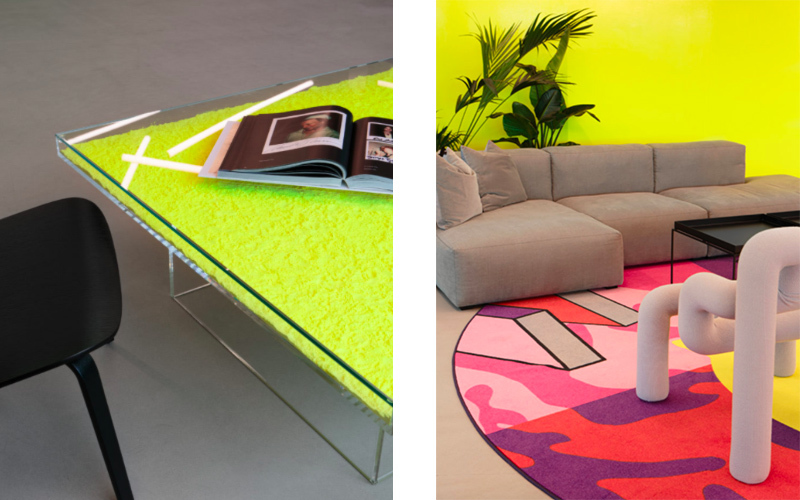 Omega Media's Oslo office: table (left) and rug (right) designed by Erling and inspired by his art collection. Photos by Nadia Norskott, all photos courtesy of Erling Løken Andersen.
Omega Media's Oslo office: table (left) and rug (right) designed by Erling and inspired by his art collection. Photos by Nadia Norskott, all photos courtesy of Erling Løken Andersen.
AA: Any thoughts on the recent NFT craze?
EA: It’s an interesting topic — I'm a huge believer in Bitcoin (I've been in the Bitcoin world since 2016 or 2017). So, I do love cryptocurrencies, but in terms of NFTs, I haven’t really made up my mind yet.
Of course, they're just another medium for art, you know, so if you love art in a way you have to like NFTs. There's nothing not to like about the concept of buying art and displaying it in some form or function. What's also practical with NFTs is that you don't need physical storage space (I run out of wall space and then I need more storage space for my art, etc.). So, in a way, it would be fantastic to just store everything digitally.
What I don't like about NFTs is that I actually like to stand back and look at art on the wall. I don't especially like looking at art on a computer or on Instagram or whatever — it's like a secondary medium to me. So, I think NFTs are definitely interesting and I do think there's a future for cryptoart, but I'm probably not going to buy too much myself, just because I don't like the format.
AA: You said that you want to pass your art collection on to your children. Do you think they’ll have the same appreciation for art — or the same style — that you have?
EA: Well, they're too young right now to appreciate it — I have a newborn and a five-year-old. The one who's five is extremely interested in art and she's terrific at drawing (it's really mind-blowing how good she is!). So, I'm definitely bringing them up in the art world.
I came from a blue-collar family — there was no interest in art, but my parents had inherited a lot of pieces and the walls of our house were just covered with them. You know, lots of different paintings, but nothing valuable. Still, it was always there, just kind of as background noise and static in my life. Even though none were by famous artists, I do think that growing up around these paintings gave me an initial appreciation of art.
I want to do that for my children, but on a much more advanced and thorough level. Recently, I took my daughter to the Astrup Fearnley Museum and she thought all of the Jeff Koons sculptures were toys, you know, because they're so polished. And I think that, if you begin understanding art from that perspective — that art can almost be like toys for grownups — then I think that’s a good place to start.
View Erling's full art collection on Artwork Archive.







